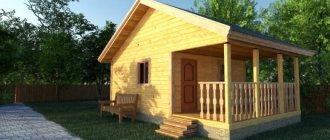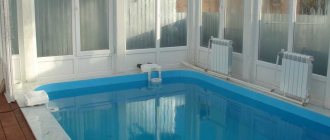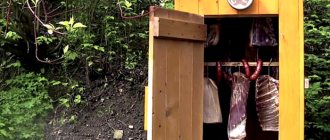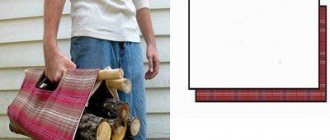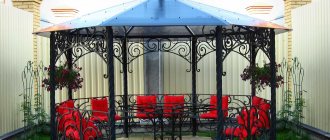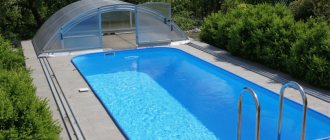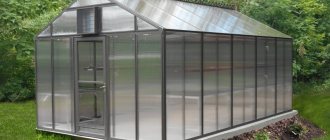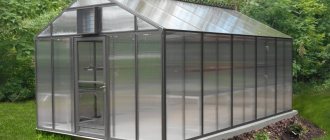Review author: Terrari School of Design
The dacha is not the only place where vegetables and fruits are grown. Today there is a chance to create real paradises that allow you to fully relax in nature from the noise, gas pollution and bustle of the city. Property owners prioritize aesthetics, comfort and functionality of the territory.
If there is no river or lake in the vicinity, then a country pool is a lifesaver in the hot summer, giving adults the opportunity to relax and children to play while practicing swimming.
Variety of offers
The owners are sure to plan a bathhouse that will not only brighten up their everyday pastime, but will also become a bright highlight of the property and a source of pride in front of their neighbors. The choice of device is influenced by the budget, space dimensions and personal wishes of the owners.
Manufacturers offer a variety of designs, and the most popular of them are:
- inflatable;
- concrete;
- frame types.
Each type of pool has individual advantages and disadvantages.
Inflatable model
The economical variation is in demand due to its affordable cost, variety of shades and format. It is simply inflated and filled, installed at any level point with a backing under the bottom. The product is convenient in that installation is carried out upon arrival, and after the season it is deflated and packed for transportation.
The advantage is also compactness and mobility, and the disadvantage is that it is not resistant to damage and lacks filtration.
A systematic change of water, cleaning, and air pumping will be required.
Stationary
The concrete modification is equipped forever and cannot be moved; it can be oval, round, square and any other shape, without holding back the imagination of the residents.
Ordering a turnkey pool of this type is much more rational, which will prevent design errors and wall collapse. It considers:
- Spectacular lighting.
- Waterfalls.
- Geysers.
- Counterflow.
- Hydromassage.
Professionals with experience in this matter will do everything correctly, but this is not a cheap pleasure. Self-construction is also not excluded. After digging a pit with an “allowance” of 20 cm and taking into account the slope in the drainage direction, the bottom after compaction is covered with sand, gravel and roofing felt. The formwork is installed and concrete mortar with hydrophobic additives is poured, leaving openings for the drain and fill pipes.
After hardening, finishing is done with ceramic tiles, mosaics, and PVC film. The masonry is original, imitating figures or paintings. This technique requires time and hard work, but the result will exceed all expectations.
After approval of the pool project, due to the complexity of the work, it will be necessary to use an excavator and assistants.
Frame type
Such a bowl will not ruin the family wallet, but will look no less exclusive. Single-level, multi-level, in-ground and surface structures are offered.
A collapsible container is an ideal version for summer residents who occasionally visit their property. It is dismantled with the arrival of autumn and placed in a utility room; it has a drain valve and a hole for a filter. The set is replenished with stairs and repair parts.
You can design it with your own hands, using boards and bars as a basis.
The static frame needs to provide fluid supply and an underground communication system. Glass inserts look unusual, striking with their respectable appearance. When giving preference to this model, they take into account the climatic specifics when choosing frost-resistant materials.
Such a pool at a summer cottage may consist of:
- polypropylene;
- plastic;
- polycarbonate
This is an environmentally friendly raw material, pleasant when in contact with the body, on which algae does not grow. The composite hot tub is factory-molded from fiberglass, is sealed, does not crack, and is aesthetically pleasing.
Disadvantages - high cost, difficult transportation, crane services.
Types of structures
Before you start designing and drawing up estimates, select the type of structure. This parameter determines the technology for performing the work and allows you to select the optimal materials.
Main types of country pools:
1 Frame - sold ready for installation. They look like a metal base on which a fabric (usually PVC film) is stretched. There are basic and complete sets of swimming pools - with a cleaning system, pump, ladder. Installation and use are seasonal. Waterproofing is required
Frame pool
2 Plastic – with polymer bowls. Plastic pools can be purchased ready for installation or ordered to be made to order. Also a seasonal – that is, summer – solution. The plastic pool must be removed in winter to avoid damage to the materials.
Plastic pool
3 Stationary – these are monolithic structures for permanent use. We will consider their arrangement below. Yes, building a stationary country pool requires a significant investment of time and money, but in the end you get a working solution that is easy to use. Reliability is high, durability is also good
Stationary pool option
Inflatable pools are also used - but this is a very simple, short-lived material . It’s easy to pierce even the most expensive product, and you’ll have to replace it. Small inflatable products can be placed in the children's area.
Pools with different depths should have a flat bottom with smooth transitions. Sudden changes are unacceptable for safety reasons.
Filling methods
Baths come in overflow types with built-in drainage grates on the sides. Water is poured to the very top and, splashing out, pours into the container, passing through the filter.
The skimmer method involves not bringing the liquid level to the very edges by 15-25 cm; in this case, it is cleaned with a skimmer.
Pros and cons of homemade products
Pros:
- There is no need to contact specialists; everything can be done with your own hands.
- Cost-effective: everything is budget-friendly and simple.
- Quick installation.
- There is no need to remove the structure when cold weather sets in.
Minuses:
- It is difficult to integrate a filter, pump and heater.
- Draining the water must be done manually or using a hose.
- If water is drained onto the beds, disinfectant chemicals cannot be used.
- Fragility.
- The appearance is not as attractive as that of the purchased model.
Location
The location of the tank is of great importance. This takes into account:
- Soil components.
- Lack of tall deciduous vegetation nearby.
- Occurrence of underwater sources.
- Soil slope.
- Distance to water supply.
- Wind rose.
Placement under trees is not recommended, otherwise the water will become clogged with falling leaves and branches, which will cause its frequent replacement. The proximity of water pipes guarantees quick filling and easy cleaning. Stationary structures are built inside the building, and any variety is built outside.
An indoor pool is popular, providing protection from the scorching sun in the heat and allowing you to take water treatments in late autumn, if there is heating.
Video description
The video shows the sequence of construction operations to install a plastic pool:
Composite pools
The raw material is fiberglass. This is a polymer based on polyester resins with the addition of glass fiber, which acts as a reinforcing frame. This composite produces lightweight but very durable structures. By the way, the hulls of boats, yachts and boats are made from it today.
Fiberglass products have a more durable structure than plastic ones. They will last at least 50 years. As for the installation method, it is exactly the same as for polystyrene models. But there is another simplified option.
- a cushion
at the bottom of the dug pit . - A bowl
is installed on it , which is set horizontally. - Fill
the space between the pool and the walls of the pit with a mixture of sand and crushed stone in a 1:1 ratio, which is compacted well. There is no need to pour water into the reservoir when adding.
Which pool is better to buy for your dacha: plastic or fiberglass. It’s probably incorrect to pose the question this way. It all depends on the price of the product and the purchasing power of consumers. Plastic ones are cheaper than composite ones, but the latter have a longer service life.
Recommendations
If the main goal is decorativeness, then a strong recess is not required, and if you want to fully swim, the depth is maintained at 1.5-2.5 m and steps with handrails are provided. The area is divided in two, providing a safe place for children swimming. A flooring made of boards is laid around, an alternative to wood is tiles, on which rubber mats or a rubber coating, or natural stone are placed.
The elevated position will provide an opportunity to admire the surrounding beauty.
A fashionable technique is to build a swimming pool close to nature, organically integrating it into the landscape design. The shore is lined with boulders and pebbles, and areas are reserved for aquatic plants. Rockeries, flower beds, cascades are welcome.
They are considering a place to relax with garden furniture, sun loungers, and gazebos. The surrounding area is planted with flowering shrubs, lawns, and conifers.
An artificial font should blend harmoniously into the surrounding landscape, performing a decorative function. In order for it to serve for a long time without repair, you need to follow the operating rules and instructions.
If chemical cleaning agents are not used, the water can be used to water green areas.
A swimming pool in a country house is not only assigned the role of a luxurious element, it contributes to a special favorable microclimate that is beneficial for health.
Preliminary calculations
Pit preparation
The main parameters of the future pool are width and depth. They are determined taking into account the purposes of construction. If you plan to mostly swim, choose a rectangular, slightly elongated bowl. Round bases are a convenient option for splashing around and relaxing.
The optimal depth of the pool is 1.4 m, but be sure to take into account the height of family members and the presence of children. For kids, 1 m will be plenty, but those who like to jump from a tower need at least 2 m.
The depth can be set to one or variable. Gradual deepening is optimal for families with children (there will be zones for everyone), ski jumping. The most difficult from a constructive point of view will be a combined pool for children and adults. In it, the zones are separated by a partition extending from the very bottom.
Photo of the pool on the site
Rules of service
The disadvantage of most homemade pools is that it is difficult to organize normal water filtration in them. Some tanks do not require the installation of additional equipment, so such bowls require more chemicals and more frequent cleaning.
Care:
- If the drainage is not done on the beds, it is necessary to use disinfectant chemicals.
- Once every 1-2 days, the bottom and surface cleaning of the bowl is carried out.
- Before winter, half the water is drained, and plastic bottles partially filled with sand are placed inside. This way the walls will be protected from cracking.
How to choose the right installation location?
The main problem is the groundwater level . You can ask the gardening association or geologists, although usually everyone knows the situation with groundwater - this can be seen in the spring, who is flooded and who is not. Plus - a well or borehole is dug on each plot. And still they try to choose a higher place.
It is also necessary to know the structure of the soil - the denser the better. If the site is designed in a certain style, then the location (taking into account the size of the pool) should already be outlined. If not, then you need to do all of the above.
The proximity of a water source is also important. For a pool with a capacity of more than 500 liters, pumping equipment is required.
Design ideas
Designing on your own can sometimes be difficult. To do this, they turn to professionals to realize all their ideas, plans and wishes.
It all starts with the choice of materials, the lining of the bowl is planned . You can choose tiles of any color or special films that are resistant to moisture. The easiest way is to paint the bowl, but the paint must be chlorine-resistant.
It all starts with the choice of material and its color
The walls can be decorated with any pattern. A marine theme would be suitable. You can place patterns on the bottom, or shade it with a different color. The wall can be decorated with plain or multi-colored mosaics. The most important thing is that all materials used to design the pool are safe and resistant to external conditions.
At night, the lighting will look interesting and create a cozy atmosphere.
This way you can go swimming during the day and evening. You can illuminate only the bottom, sides, or the entire body of water and its surrounding area by choosing spotlights, special lamps for underwater lighting, or LED strips.
Use a backlight for extra light
If the pond has sides, you can decorate them stylishly. It can be decorative stone, granite, special tiles, or material stylized as wood. Since this is a recreation area, you can pour sand around the sides, decorating everything in a beach style.
From the house, gazebo or any recreation areas, you can lay a path lined, for example, with pebbles, wood cuts, or tiles. And arrange small bushes, flowers, or flowerpots with vegetation along them.
We create a convenient descent and rest area
Tools for work
Polypropylene film for soil waterproofing
Materials and tools are selected based on the type of pool and design. You will need:
- shovel, pickaxe, if you plan to dig a trench; if the pit is large, you need to rent special equipment;
- frame material - pallets, boxes, metal pipes, reinforcement for a concrete bowl;
- tools for processing materials - plane, jigsaw, hacksaw, saw, etc.;
- measuring instruments - tape measure, plumb line, level;
- fasteners - screws, nails, metal corners, tape, etc.;
- waterproofing film;
- concrete if a permanent pool is being built;
- finishing or cladding materials – paint, varnish, tiles:
- maintenance materials - pipes, nozzles, flanges, pump, skimmer or storage tank if the pool is drained.
Additional materials and equipment: concrete mixer, screwdriver, construction stapler, felt and so on.
Available materials
Pit for a swimming pool
A standard drawback of a temporary structure is the need for frequent changes of water. If this is not scary and the area is small, the option of scrap materials is quite suitable.
- The simplest option is a pit covered with polypropylene film. In any suitable area, dig a trench of the required depth and width. The bottom is lined with construction cardboard to make walking softer, the walls are covered with bags so that the film does not tear. Then the pit is covered with a waterproofing film, and its edges are secured with stones, at the same time finishing the artificial reservoir. The disadvantage of this solution is the limited size of the pond, since the film cannot withstand high pressure.
- Frame version made of pallets - the pool bowl is constructed from 9 pallets, fastening them with slats and screws. A pit is not needed for this model; the pond is placed on a flat surface, covered with a thick tarpaulin. The inside of the “bowl” is covered with greenhouse film, and then with old bedspreads and blankets. This gasket ensures soft walls. At the last stage, the pool is covered with a bright-colored waterproofing film and glued to the sides with adhesive tape. Disadvantage: the size is small, and it will not last long.
- In addition to pallets, you can use old wooden or plastic boxes. They are assembled into a rectangular structure on slats and additionally wrapped around the perimeter with plastic tape. Install the pool on a tarpaulin or banner film. The disadvantages of the model are the same.
- An interesting idea is a hay pond. The bottom of the proposed reservoir is covered with hay, and the walls are constructed from dense hay bales. The structure is tightened with belts, lined with cardboard or tarpaulin to prevent damage to the main film, and then covered with a waterproofing sheet. Such a pool can be quite large, but its depth is small. Disadvantage: he is not at all attractive.
A frame pool for a summer residence is also made by hand. The structure is welded from profile pipes and lined from the inside with a waterproofing film. You can install such a pond on any flat area.
There are other options, for example, a children's pool can be made from a large car wheel.


